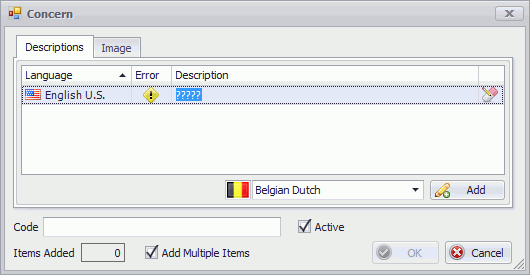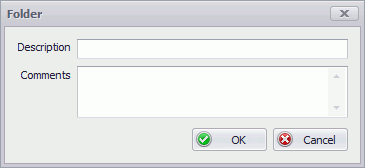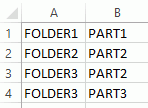What are Concerns?
Concerns are the things that can go wrong with a part. To prepare for your Inspect launch you need to prepare a standardized list of concerns with which inspectors will record defects. Review the list of concerns with your planning team’s stakeholders to ensure that you have assembled a comprehensive list of concerns. Be sure to remove confusing, ambiguous or duplicate concern names. When making a list of quality concerns it is critical to note that you identify only the concern name. DO NOT include the part name in the concern name.
Incorrect Concern Name |
Correct Concern Name |
Missing brake |
Missing |
Scratched cross bar |
Scratched |
Loose seat tube |
Loose |
Creating Concerns
Select the Attribute tab.
Click Concerns.
A list of the existing concerns is displayed in the right-hand pane.
Click the add icon (![]() ) below the right-hand pane.
) below the right-hand pane.
The following popup appears.

Enter a description and code for the concern.
If required, add an image in the Image tab.
For a description of how to add an image see here.
Click OK.
The concern is added to the list.
The concern can now be associated to a part. See here.
Creating Concern Folders
Concern Folders are used to make a large list of concerns more manageable since folders reduce the amount of scrolling you need to do.
Select the Attribute tab.
Click Concerns.
A list of the existing concern folders is displayed in the left-hand pane.
Click the add icon (![]() ) below the left-hand pane.
) below the left-hand pane.
The following popup appears:

Enter a description.
Enter comments if required.
Click OK.
The folder is added to the list.
Drag and drop concerns from the right-hand pane onto the folders in the left-hand pane to associate them.
Importing Concerns and Folders
Concerns and concern folders can be specified in an Excel spreadsheet and then imported directly to the Inspect database.
There are three different import options. Each one requires a separate spreadsheet and different information as shown below:
|
Data being imported |
Information required in first two columns |
|
Concerns |
Concern description, Concern code |
|
Concern Folders |
Concern folder description, Concern folder code |
|
Concern Folders / Concerns |
Concern folder code, Concern code |
Create the spreadsheet
Create a new spreadsheet.
Fill in the required information as listed in the table above.
There is no header row.
If you are importing concern folders and concerns then you can include as many combinations as you like, as shown below.

Save the file with a descriptive name.
Import the spreadsheet
Select the Attribute tab.
Click Concerns.
A list of the existing concern folders and concerns is displayed.
Import as follows:
Concerns - Click the Import button ( ) below the right-hand pane.
) below the right-hand pane.
Concern Folders - Click the Import button ( ) below the left-hand pane, select Folders and click OK.
) below the left-hand pane, select Folders and click OK.
Concern Folders / Concerns - Click the Import button ( ) below the left-hand pane, select Folders/Items and click OK.
) below the left-hand pane, select Folders/Items and click OK.
The Import Wizard window opens.
Click Next.
Either enter a file path or click the folder icon to locate and open the spreadsheet.
The spreadsheet information is checked to see if it is valid. Invalid data will be highlighted in red.
If required, select the Errors tab to see which data is incorrect.
Errors must be fixed in the original spreadsheet. You can then click the Refresh button ( ) in the wizard to re-import the spreadsheet.
) in the wizard to re-import the spreadsheet.
Click Next.
If required, disable any items you don't want to import.
Click Next.
Click Finish.
The data is imported to the Inspect database.